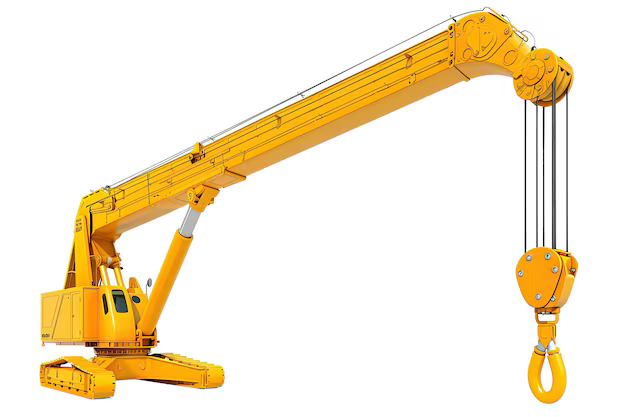- Home
- Our Products
- Creane Parts
- Boom Crane

Description
Boom cranes are versatile lifting devices commonly used in construction, manufacturing, and heavy-duty material handling applications. These cranes feature a long, extendable arm or boom that can be adjusted to reach and lift materials at varying heights and distances. The boom is mounted on a rotating base, allowing for a wide range of movement and flexibility in positioning the load. Boom cranes come in several configurations, including truck-mounted, crawler-mounted, and stationary models, each designed for specific operational needs and environments. Truck-mounted boom cranes offer mobility and can be quickly relocated between job sites, while crawler-mounted cranes provide stability and are ideal for uneven or soft ground conditions. Stationary boom cranes are often used in fixed locations, such as ports or warehouses, for repetitive lifting tasks. Modern boom cranes are equipped with advanced features such as hydraulic controls, load sensors, and safety systems to enhance precision, safety, and efficiency. Regular maintenance, including inspections of the boom, hydraulic systems, and safety features, is essential to ensure reliable performance and longevity. By offering flexibility and powerful lifting capabilities, boom cranes play a crucial role in efficiently handling heavy and oversized loads in various industrial and construction settings.
Industry Used
FAQ
A boom crane is used for lifting and moving heavy loads vertically and horizontally. It is commonly used in construction, manufacturing, and logistics to handle materials and equipment in various applications.
Common types of boom cranes include truck-mounted cranes, crawler cranes, and stationary or tower cranes. Each type is designed for specific applications and provides different lifting capacities and mobility.
Consider factors such as the load capacity, boom length, lifting height, and mobility requirements. The type of job site and the nature of the loads being lifted will also influence your choice. Our team can help you select the most suitable boom crane based on your requirements.
Key components typically include the boom (lifting arm), jib (extended arm), hoist or winch, counterweights, and the base or chassis. Each component plays a role in the crane’s lifting and stability.
Regular maintenance includes inspecting and lubricating moving parts, checking hydraulic systems, and ensuring the integrity of structural components. Follow the manufacturer’s maintenance schedule and guidelines to ensure safe and efficient operation.
Ensure that the crane is equipped with safety features such as overload protection, stabilizers, and emergency stop systems. Operators should be trained in safe lifting practices and the crane should be regularly inspected for safety compliance.
Yes, boom cranes can be customized to meet specific needs, such as extended boom lengths, specialized lifting attachments, or enhanced mobility features. Contact us to discuss your requirements and explore custom solutions.
If you encounter performance issues, check for common problems such as mechanical failures, hydraulic leaks, or improper settings. Consult the crane’s manual for troubleshooting tips and contact our service team for professional assistance if needed.
Boom configurations include telescopic booms (which extend and retract), lattice booms (with a truss structure for added strength), and articulating booms (which can bend or pivot). The choice depends on the type of work and required reach.
Boom cranes are used in various applications such as construction sites for lifting materials, in manufacturing for moving heavy components, and in logistics for loading and unloading goods. They are essential for tasks that require precise lifting and placement of heavy objects.

